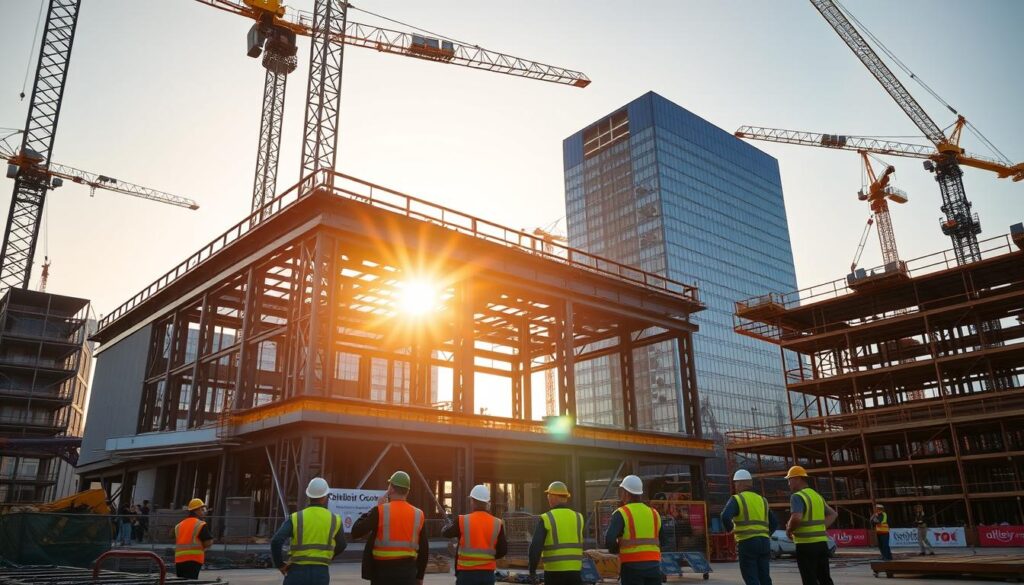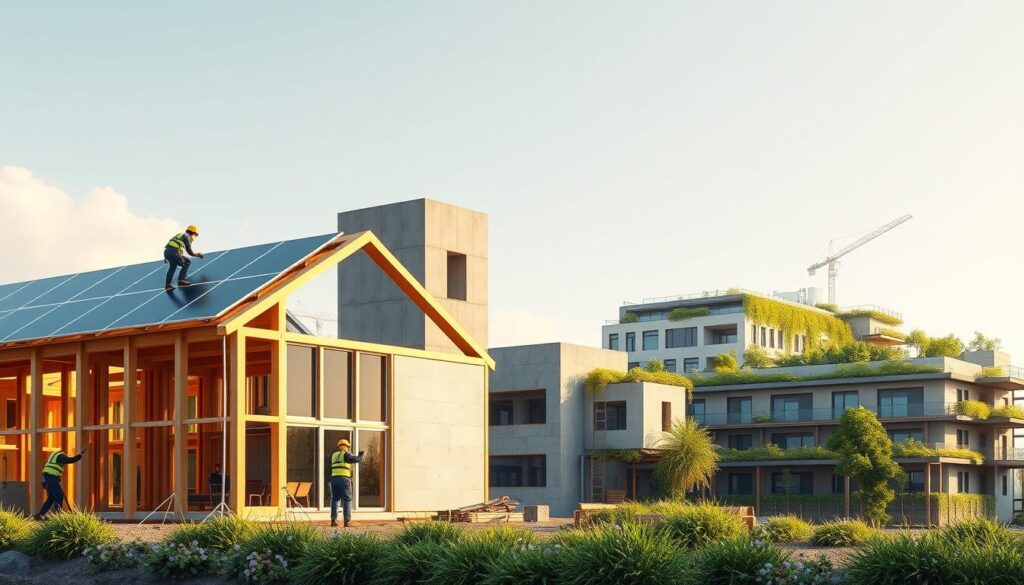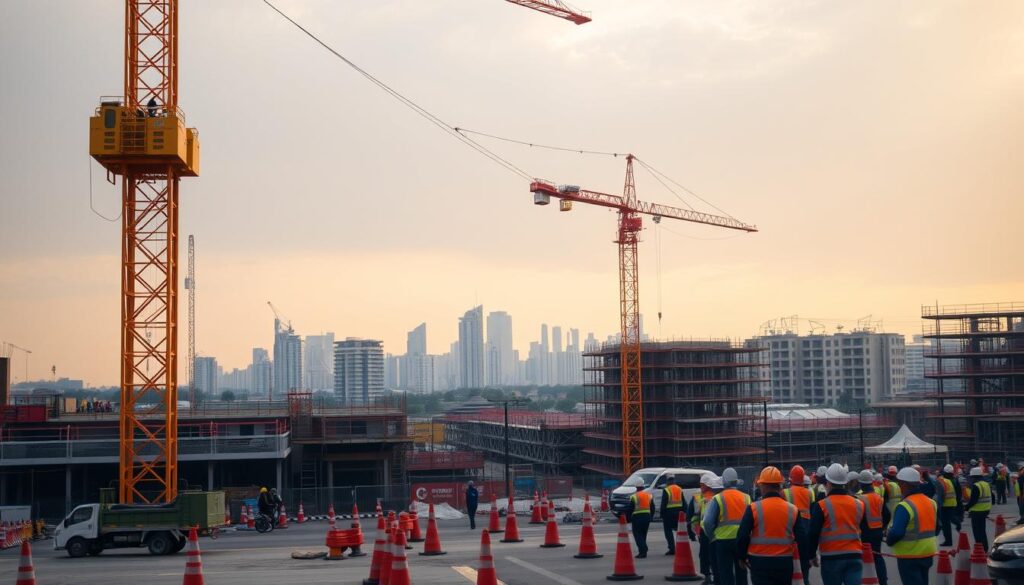The global construction industry is witnessing unprecedented growth, with megaprojects like NEOM and the Grand Paris Express pushing the boundaries of innovation and complexity. Effective construction project management is crucial for the success of these international developments.
Global construction trends are shifting towards more sophisticated and integrated management strategies, driven by the need for sustainability, efficiency, and cost-effectiveness.
As the industry continues to evolve, it’s essential to adopt advanced management strategies that can handle the complexities of international developments.
Key Takeaways
- Effective construction project management is crucial for international developments.
- Megaprojects drive innovation in the global construction industry.
- Global construction trends emphasize sustainability and efficiency.
- Advanced management strategies are necessary for complex projects.
- The industry is shifting towards integrated management approaches.
Understanding the Global Construction Landscape
The global construction industry is undergoing significant transformations driven by technological innovation and sustainability. As a result, understanding the current landscape is crucial for stakeholders looking to navigate this complex and evolving sector.
The global construction landscape is characterized by large-scale infrastructure projects, technological innovation, and a growing emphasis on sustainability. These factors are reshaping the industry, creating new opportunities and challenges for construction management professionals.
Key Trends in International Construction
Several key trends are influencing the global construction industry. These include:
- Increased use of technology: Technologies such as Building Information Modeling (BIM) and drones are improving project efficiency and accuracy.
- Sustainability and green building: There is a growing focus on sustainable construction practices and green building standards.
- Infrastructure development: Governments are investing heavily in infrastructure projects, driving growth in the sector.
These trends are transforming the construction industry, enabling companies to deliver projects more efficiently and sustainably. For more insights on the dynamic evolution of construction management, visit LEK Consulting.
Market Entry Strategies
Entering new markets in the global construction industry requires careful planning and strategic decision-making. Companies must consider factors such as local regulations, market conditions, and cultural nuances.
| Market Entry Strategy | Description | Benefits |
|---|---|---|
| Joint Ventures | Partnering with local companies to leverage their expertise and networks. | Access to local knowledge, shared risk. |
| Acquisitions | Acquiring existing companies to establish a presence in the new market. | Quick market entry, established customer base. |
| Organic Growth | Gradually expanding operations through internal development. | Control over growth, minimal risk. |
By understanding these key trends and market entry strategies, construction companies can better navigate the complexities of the global construction landscape and capitalize on emerging opportunities.
Importance of Advanced Strategies in Construction

Innovation is at the heart of modern construction, enabling companies to deliver projects that are not only efficient but also sustainable. The incorporation of advanced strategies in construction is transforming the industry, making it more adept at handling complex international projects.
The benefits of adopting innovative approaches in construction are multifaceted. They include improved project efficiency, reduced costs, and enhanced sustainability. For instance, technologies like digital twins and modular assembly are revolutionizing the way construction projects are planned and executed. According to recent trends, such innovative methods are becoming increasingly popular in international developments.
Benefits of Innovative Approaches
The construction industry is witnessing a significant shift towards innovation, driven by the need for efficient project planning and execution. Advanced strategies such as Building Information Modeling (BIM) and prefabrication are enhancing project outcomes by reducing timelines and improving quality.
- Improved collaboration among project stakeholders
- Enhanced accuracy in project planning
- Reduced environmental impact through sustainable practices
Overcoming Challenges in International Projects
International construction projects often face unique challenges, including regulatory compliance, cultural differences, and logistical complexities. Adopting sustainable construction methods not only helps in overcoming these challenges but also contributes to the project’s overall success.
By leveraging advanced strategies, construction companies can better navigate the complexities of international projects. This includes utilizing technology for better project monitoring and adopting sustainable practices to minimize environmental impact.
Effective Project Planning Techniques
The success of international construction projects hinges on effective project planning, which involves leveraging technology and setting clear objectives. In the complex and dynamic environment of global construction, a well-planned project is crucial for achieving the desired outcomes on time, within budget, and to the required quality standards.
Utilizing Technology in Planning
Technology plays a pivotal role in modern construction project planning. Advanced software solutions enable project managers to create detailed project schedules, allocate resources efficiently, and monitor progress in real-time. Building Information Modeling (BIM) is one such technology that has revolutionized the planning phase by allowing for the creation of detailed digital models of the project.
The use of technology in project planning also facilitates better collaboration among stakeholders. Cloud-based platforms enable teams to share information, track changes, and communicate effectively, regardless of their geographical location.
Establishing Clear Objectives
Clear objectives are fundamental to the success of any construction project. By establishing well-defined goals, project managers can ensure that all stakeholders are aligned and working towards the same outcomes. This involves setting specific, measurable, achievable, relevant, and time-bound (SMART) objectives that guide the project’s execution.
| Objective | Description | Benefits |
|---|---|---|
| Specific | Clearly defines what needs to be achieved | Ensures focus on key outcomes |
| Measurable | Quantifiable targets for progress tracking | Facilitates monitoring and evaluation |
| Achievable | Realistic goals based on available resources | Boosts team morale and motivation |
| Relevant | Aligns with the overall project strategy | Ensures strategic alignment |
| Time-bound | Specific deadlines for completion | Enhances project scheduling and control |
By combining the use of advanced technology with the establishment of clear objectives, construction project managers can significantly enhance the effectiveness of their project planning. This not only improves project outcomes but also reduces the risks associated with international construction projects.
Risk Management in International Projects

The complexity of international construction projects demands robust risk management strategies. International projects face various risks, including currency fluctuations, regulatory changes, and logistical complexities.
Identifying Potential Risks
Identifying potential risks is the first step in effective risk management. This involves analyzing market trends, understanding local regulations, and anticipating logistical challenges. According to a study on international construction risk management, proactive risk identification can significantly reduce project delays and cost overruns.
- Currency fluctuations
- Regulatory changes
- Logistical complexities
- Supply chain disruptions
Mitigation Strategies
Once potential risks are identified, effective mitigation strategies must be implemented. These can include:
- Developing contingency plans for potential risks
- Investing in insurance to cover unforeseen events
- Building strong relationships with local partners to navigate regulatory environments
- Utilizing advanced project management tools to monitor and control project progress
As noted by industry experts, “A proactive approach to risk management is crucial for the success of international construction projects.” Effective risk management not only mitigates potential downsides but also enhances the overall viability and profitability of projects.
“Risk management is not just about mitigating risks; it’s about creating opportunities.”
By adopting best practices in construction management and infrastructure development strategies, project managers can better navigate the complexities of international projects. This includes staying informed about market trends, leveraging technology for project monitoring, and fostering a culture of proactive risk management.
Building a Diverse Project Team
Creating a project team that is both diverse and culturally aware is essential for navigating the complexities of global construction projects. A diverse team brings together individuals with different backgrounds, experiences, and perspectives, which can lead to more innovative solutions and better decision-making.
Importance of Cultural Competence
Cultural competence is critical in international construction projects as it enables team members to understand and respect different cultural norms, values, and practices. This understanding fosters a collaborative environment where team members can work effectively together, regardless of their cultural backgrounds.
Culturally competent teams are better equipped to manage conflicts, improve communication, and enhance overall project performance. By being aware of cultural differences, team leaders can adopt appropriate management strategies that cater to the diverse needs of their team members.
Hiring Local Expertise
Hiring local experts is another crucial aspect of building a diverse project team. Local experts bring invaluable knowledge about the local market, regulations, and cultural nuances, which can significantly impact project success.
- Local experts can facilitate smoother project execution by navigating local bureaucracies and regulations more effectively.
- They can also provide insights into local labor practices, market conditions, and environmental considerations, helping to mitigate potential risks.
By combining local expertise with international experience, construction companies can create a powerful synergy that drives project success and fosters a competitive edge in the global market.
Communication Strategies for Global Teams

In the realm of international construction, communication strategies play a pivotal role in project success. Effective communication is critical to ensuring that all stakeholders are aligned and working towards the same objectives.
The complexity of global construction projects demands robust communication tools that can facilitate collaboration across different geographical locations and time zones. Utilizing technology is key to bridging the communication gap.
Tools for Effective Collaboration
Several tools can enhance collaboration among global teams. These include:
- Project management software like Asana or Trello
- Communication platforms such as Slack or Microsoft Teams
- Video conferencing tools like Zoom or Google Meet
These tools help in streamlining communication and ensuring that all team members are on the same page. For instance, a project management software can be used to assign tasks, track progress, and share updates.
Importance of Regular Updates
Regular updates are crucial in keeping all stakeholders informed about project progress. This can be achieved through:
- Weekly or bi-weekly project meetings
- Daily or weekly progress reports
- Ad-hoc updates for critical issues
As emphasized by a construction industry expert, “Regular communication is the lifeline of any successful project. It ensures that everyone is aligned and working towards the same goal.”
“The key to successful project management is the ability to communicate effectively with all stakeholders.”
To illustrate the impact of effective communication, let’s consider the following table that highlights the benefits of regular updates in global construction projects:
| Benefits | Description | Impact |
|---|---|---|
| Improved Transparency | Regular updates keep stakeholders informed | Enhanced trust among stakeholders |
| Timely Issue Resolution | Prompt communication helps in addressing issues quickly | Reduced project delays |
| Better Collaboration | Effective communication fosters teamwork | Increased productivity |
By implementing these communication strategies, global construction teams can overcome the challenges associated with international projects and achieve success.
Leveraging Data Analytics
The construction industry is on the cusp of a revolution, driven by the power of data analytics. As construction projects become increasingly complex, the need for data-driven insights is growing. Data analytics is transforming the construction landscape, enabling more informed decision-making and predictive capabilities that were previously unimaginable.
Data-Driven Decision Making
Data analytics allows construction companies to make decisions based on concrete data rather than intuition. By analyzing data from various sources, including project management software, sensors, and other IoT devices, companies can gain a deeper understanding of their operations. This insight can lead to improved project outcomes, reduced costs, and enhanced efficiency.
Key benefits of data-driven decision making include:
- Improved project planning and execution
- Enhanced risk management through predictive analytics
- Better resource allocation and utilization
- Increased transparency and accountability
Predictive Analytics in Construction
Predictive analytics is a subset of data analytics that involves using historical data to forecast future events. In construction, predictive analytics can be used to anticipate potential delays, identify areas of cost overrun, and optimize resource allocation. By leveraging predictive models, construction companies can proactively address issues before they become major problems.
The application of predictive analytics in construction can lead to significant improvements in project delivery. For instance, predictive models can help in:
- Identifying potential bottlenecks in the construction process
- Forecasting weather-related delays and developing mitigation strategies
- Optimizing supply chain logistics
To illustrate the impact of data analytics in construction, consider the following table that compares traditional project management methods with data-driven approaches:
| Aspect | Traditional Method | Data-Driven Approach |
|---|---|---|
| Project Planning | Based on experience and intuition | Utilizes historical data and predictive models |
| Risk Management | Reactive, addressing issues as they arise | Proactive, anticipating and mitigating risks |
| Resource Allocation | Often inefficient, leading to waste and overruns | Optimized based on data insights, reducing waste |
As the construction industry continues to evolve, the role of data analytics will only grow in importance. Companies that embrace data-driven decision-making and predictive analytics will be better positioned to succeed in a competitive and increasingly complex market.
Sustainable Construction Practices

As the world shifts towards more environmentally conscious practices, sustainable construction methods have become a cornerstone in international development projects. This shift is driven by the need to reduce the environmental footprint of construction activities while promoting sustainable development.
Significance of Sustainability in Global Development
Sustainability plays a vital role in international construction projects, offering numerous benefits, including reduced energy consumption, lower operational costs, and enhanced project viability. By adopting sustainable construction methods, developers can minimize environmental impact while improving the quality of life for building occupants.
The importance of sustainability is further underscored by its potential to drive innovation in the construction industry. As projects increasingly incorporate green technologies and sustainable practices, the industry as a whole is pushed towards more environmentally friendly and efficient construction methods.
Implementing Green Building Standards
Green building standards are critical in guiding the implementation of sustainable practices in construction. These standards provide a framework for developers to follow, ensuring that projects meet rigorous environmental and energy efficiency criteria.
To effectively implement green building standards, developers should focus on several key strategies:
- Conduct thorough environmental impact assessments to identify areas for improvement.
- Specify materials and systems that are energy-efficient and sustainable.
- Incorporate renewable energy sources, such as solar or wind power, into project designs.
- Implement waste reduction and recycling programs during construction.
By adopting these strategies, developers can not only comply with green building standards but also contribute to the broader goal of sustainable infrastructure development.
Effective implementation of infrastructure development strategies that prioritize sustainability requires a collaborative effort among stakeholders, including developers, policymakers, and local communities. Together, they can drive the adoption of sustainable construction practices, ultimately shaping a more sustainable future for global infrastructure development.
Quality Control and Assurance
Quality control and assurance are the backbone of successful construction management, enabling projects to meet stringent international standards. “Quality is not an act, it is a habit,” as Aristotle once said, emphasizing the importance of consistent quality in all aspects of construction.
Establishing Quality Benchmarks
Establishing clear quality benchmarks is the first step towards ensuring that construction projects meet the required standards. This involves setting specific, measurable, achievable, relevant, and time-bound (SMART) objectives for quality. By doing so, construction companies can ensure that their projects are executed with precision and care, ultimately leading to higher client satisfaction.
According to industry experts, adopting construction management best practices is crucial for maintaining high-quality standards. This includes implementing rigorous testing and inspection protocols to identify and rectify any defects or deviations from the set benchmarks.
Regular Audits and Assessments
Regular audits and assessments are vital components of a robust quality control and assurance system. These processes help in identifying areas for improvement and ensuring that the project adheres to the established quality benchmarks. By conducting regular audits, construction companies can mitigate risks, reduce costs associated with rework, and enhance their reputation for delivering high-quality projects.
As emphasized by industry leaders, “Regular quality audits are essential for maintaining compliance with industry standards and regulations.” This underscores the importance of integrating quality control and assurance into every phase of the construction project.
By focusing on quality control and assurance, construction companies can not only meet but exceed client expectations, thereby fostering long-term relationships and driving business growth.
Adapting to Local Regulations and Standards

Understanding and adhering to local regulations is essential for international construction projects to avoid costly delays and penalties. Compliance with these regulations is not just a legal necessity but also a critical factor in ensuring the project’s overall success.
Navigating Legal Requirements
Navigating the complex landscape of local regulations requires a thorough understanding of the legal framework governing construction projects in the host country. This involves familiarizing oneself with building codes, zoning laws, and environmental regulations. Effective navigation of these legal requirements can be achieved by:
- Conducting thorough research on local laws and regulations
- Engaging local legal experts to provide guidance
- Regularly updating knowledge to reflect changes in legislation
For more insights on managing construction projects, you can visit this resource on managing civil engineering projects.
Building Strong Relationships with Authorities
Building strong relationships with local authorities is crucial for ensuring compliance and facilitating smooth project execution. This can be achieved by:
- Establishing open lines of communication
- Demonstrating a commitment to compliance and transparency
- Engaging in proactive dialogue to address potential issues
By adopting these strategies, international construction projects can not only comply with local regulations but also foster a positive working relationship with local authorities, ultimately contributing to the project’s success.
Financial Management Strategies
Financial management strategies play a vital role in the success of global construction endeavors. Managing the financial aspects of international construction projects is complex and requires careful planning and execution.
Effective financial management involves several key components, including budgeting and currency risk management. These elements are crucial for maintaining profitability and ensuring the project’s overall success.
Budgeting for International Projects
Budgeting is a critical aspect of financial management in international construction projects. It involves estimating costs, allocating resources, and establishing financial benchmarks. A well-structured budget helps in tracking expenses and making informed decisions.
To create a comprehensive budget, project managers should consider various factors, including labor costs, material expenses, and regulatory compliance costs. Utilizing advanced project management tools can facilitate this process.
| Budget Component | Description | Estimated Cost |
|---|---|---|
| Labor Costs | Costs associated with hiring local and international labor | $1,000,000 |
| Material Expenses | Costs of materials and equipment for the project | $2,000,000 |
| Regulatory Compliance | Costs associated with meeting local regulations and standards | $500,000 |
Currency Risk Management
Currency risk management is another vital aspect of financial management in international construction projects. Fluctuations in currency exchange rates can significantly impact project costs and profitability.
To mitigate currency risks, project managers can employ several strategies, including hedging, diversification, and regular financial monitoring. Forward contracts and options are common hedging techniques used to manage currency exposure.
“The key to successful currency risk management is proactive planning and continuous monitoring of exchange rates.”
By adopting robust financial management strategies, including thorough budgeting and effective currency risk management, international construction projects can better navigate financial complexities and achieve their objectives.
Client Relationship Management

Fostering trust and understanding with clients is essential for the success of international construction projects. Effective client relationship management involves more than just communication; it’s about creating a partnership that benefits both parties.
Building Trust with Clients
Trust is the foundation of any successful client relationship. In the construction industry, this means being transparent about project timelines, budgets, and potential challenges. Regular updates and open communication channels help in building this trust. It’s also crucial to deliver on promises and maintain a high level of professionalism.
One way to build trust is by being proactive in addressing client concerns. This can involve implementing innovative solutions to unexpected problems, demonstrating a commitment to finding solutions that meet the client’s needs.
Understanding Client Needs
Understanding the specific needs and goals of each client is vital. This involves taking the time to listen to their requirements and preferences, and tailoring the project approach accordingly. Client-centric strategies ensure that the project deliverables meet or exceed client expectations.
To achieve this, construction companies can utilize customer service training for their teams, ensuring that everyone is aligned with the goal of delivering exceptional client experiences. Additionally, leveraging technology to gather and analyze client feedback can provide valuable insights into areas for improvement.
By focusing on building trust and understanding client needs, construction companies can enhance their client relationship management practices. This not only leads to successful project outcomes but also fosters long-term partnerships and referrals, driving business growth in the competitive construction industry.
Innovations in Construction Technology
Innovations in construction technology are redefining the boundaries of what is possible, enabling the creation of complex structures with unprecedented precision and speed. The construction industry is witnessing a significant shift towards digitalization, driven by the need for efficiency, sustainability, and cost-effectiveness.
Recent Technological Advancements
The construction sector has seen the introduction of various groundbreaking technologies in recent years. Some of the most impactful include:
- Artificial Intelligence (AI): AI is being used for predictive analytics, helping in project planning, and optimizing resource allocation.
- Building Information Modeling (BIM): BIM technology allows for the creation of detailed digital representations of physical and functional characteristics of buildings.
- Robotics and Automation: Robotics is enhancing site safety and efficiency by automating tasks such as bricklaying and demolition.
- Internet of Things (IoT): IoT devices are being used for real-time monitoring of construction sites, improving safety and enabling data-driven decision-making.
These technologies are not only improving the efficiency and quality of construction projects but are also enhancing safety and reducing environmental impact.
Future Trends to Watch
As the construction industry continues to evolve, several future trends are expected to shape its landscape:
- Digital Twins: The use of digital twins is expected to become more prevalent, allowing for real-time monitoring and simulation of construction projects.
- Advanced Materials: Innovations in materials science are leading to the development of stronger, more sustainable building materials.
- 3D Printing: 3D printing technology is poised to revolutionize construction by enabling the rapid creation of complex structures.
Embracing these trends will be crucial for construction companies aiming to stay ahead in a competitive market. By adopting and integrating these technologies, the industry can look forward to a future characterized by increased efficiency, sustainability, and innovation.
Enhancing Site Safety Measures

Effective site safety measures are essential for the success of construction projects and the well-being of personnel. Ensuring a safe working environment is a top priority in the construction industry, where hazards are inherent and risks are high.
Safety Training
Safety training is a critical component of construction management best practices. It equips workers with the knowledge and skills necessary to identify and mitigate potential hazards on site. Comprehensive safety training programs should be implemented from the onset of a project, covering topics such as:
- Personal Protective Equipment (PPE) usage
- Hazard recognition and risk assessment
- Emergency response procedures
- Safe work practices for specific tasks
For more insights on the latest trends in construction safety management, visit Struxhub’s blog on construction safety management.
Implementing Safety Protocols
Implementing robust safety protocols is vital for maintaining a safe working environment. These protocols should be tailored to the specific needs of each project, taking into account factors such as site layout, project scope, and local regulations. Key elements of effective safety protocols include:
- Regular safety inspections and audits
- Clear communication channels for reporting hazards
- Incident investigation and corrective action processes
- Continuous training and reinforcement of safe practices
Refer to World Civil Society’s safety guidelines for construction for detailed safety guidelines.
By prioritizing site safety and investing in comprehensive safety training and protocols, construction companies can significantly reduce the risk of accidents and create a safer, more productive work environment.
Case Studies of Successful International Projects
Successful international construction projects are often characterized by their ability to adapt to diverse environments and regulatory frameworks. This adaptability, combined with the effective implementation of international construction techniques, plays a crucial role in their success.
Examining case studies of such projects provides valuable insights into best practices and project success factors. These case studies highlight the importance of innovative approaches, robust management strategies, and the ability to navigate complex challenges.
Lessons Learned from Global Leaders
Global leaders in international construction have shared valuable lessons through their experiences. One key takeaway is the importance of cultural competence and understanding local regulations. For instance, a project in the Middle East might require different strategies compared to one in Europe, due to differences in legal frameworks and cultural norms.
The use of advanced technology, such as Building Information Modeling (BIM), has also been a common factor among successful projects. BIM allows for more accurate planning, reduced waste, and improved collaboration among stakeholders.
Analyzing Project Success Factors
Analyzing the success factors of international construction projects reveals several common themes. These include effective project planning, robust risk management, and the ability to adapt to changing circumstances.
| Success Factor | Description | Impact |
|---|---|---|
| Effective Planning | Utilizing advanced planning techniques and tools | Reduces delays and cost overruns |
| Risk Management | Identifying and mitigating potential risks | Minimizes disruptions and financial losses |
| Adaptability | Being able to adjust to changing project requirements | Ensures project continuity and success |
By understanding and applying these success factors, construction companies can improve their chances of delivering successful international projects. The insights gained from case studies of global leaders can serve as a valuable guide in this endeavor.
Future Outlook for International Construction
The international construction industry is poised for significant growth, driven by emerging markets and technological innovation. As global construction trends continue to evolve, new opportunities are emerging in regions with increasing infrastructure demands.
Shaping the Industry’s Future
Emerging markets are expected to play a crucial role in shaping the future of international construction. With the average age of craft workers projected to be 46 years by 2030, the industry will need to adapt to changing workforce demographics. According to recent data, the construction sector had an average of 382,000 job openings each month between August 2023 and July 2024, highlighting the need for skilled labor.
For more insights on the industry’s outlook, visit Deloitte’s Engineering and Construction Industry Outlook. The future outlook for international construction will be characterized by technological advancements, sustainability, and evolving global construction trends.
Predictions for the Next Decade
Over the next decade, the industry is expected to witness significant investments in infrastructure, driven by government initiatives and private equity investments. With 44% of current skill requirements in infrastructure expected to evolve, the industry will need to invest in workforce development and training programs.
